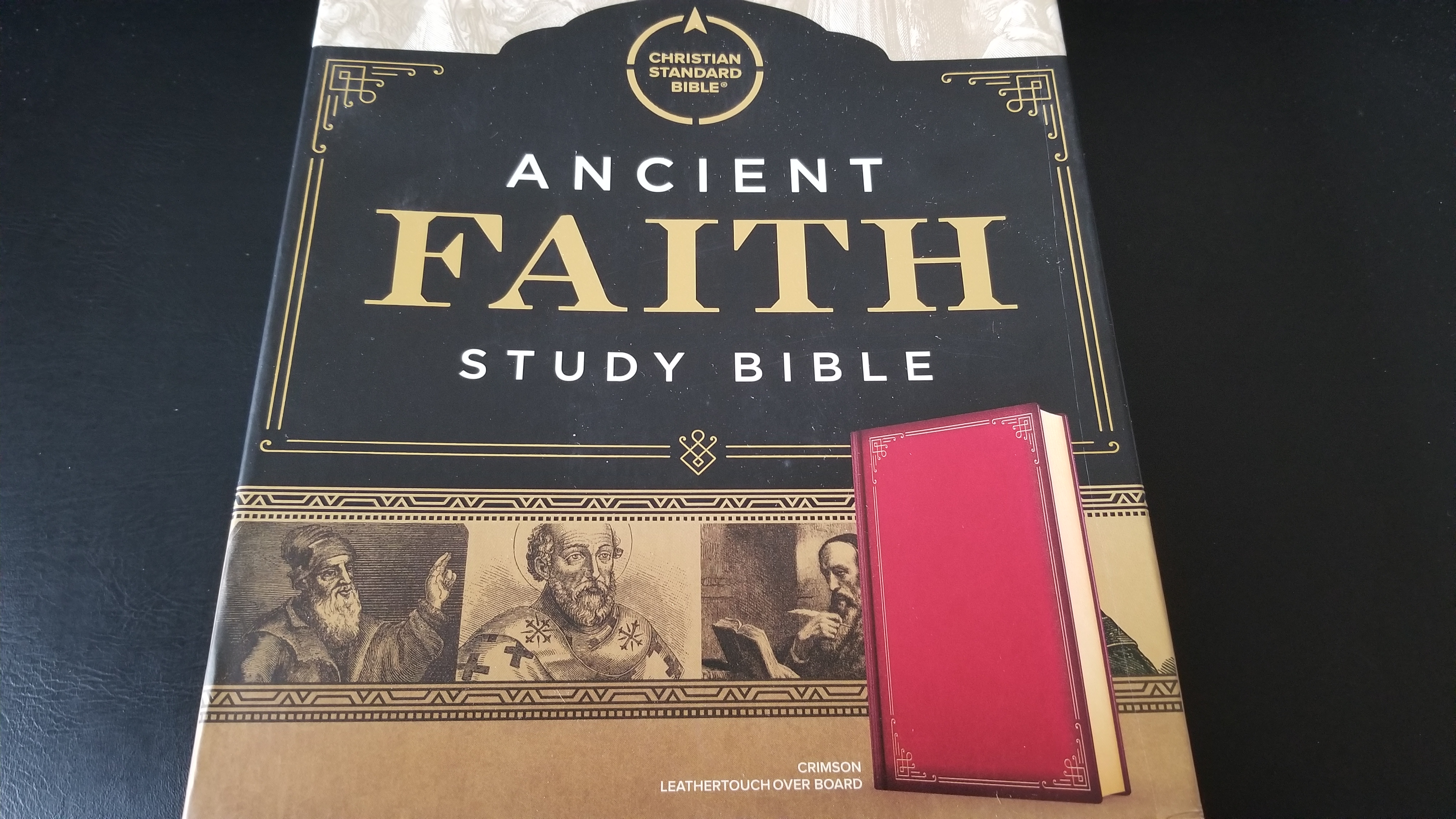
Last week, reader Deacon Dave sent me a link to the new Ancient Faith Study Bible from Holman Bibles — the publisher of the Christian Standard Bible (CSB) translation. I quickly ordered a copy. The description promised study notes and commentary from the early church fathers, a sewn binding, biographies of 25 of the most prominent early fathers, and “Twisted Truth” insets “describing where some ancient thinkers drifted from orthodoxy.”
This bible is available in hardcover, as well as tan or crimson imitation leather-wrapped hardcover. It is currently sold exclusively through Lifeway, but I suspect it will eventually be sold through Amazon, Christianbook, and other retailers.
I was fascinated to see how a protestant publisher would handle these writings. I also have very little experience with the CSB translation. A few years ago, it was known as the Holman Christian Standard Bible (HCSB), but the publisher’s name was dropped in recent years. According to the official website for the translation, the translators completed a revision of the translation at the same time that the name was changed. The revision included a number of systematic changes which are detailed on this page. Interestingly, the old HCSB used “Yahweh” for God’s name in the Old Testament, and the revisers decided to change this to “LORD” in line with most other English bibles.
Similar to many English translations, the translators refer to their guiding principle as “Optimal Equivalence,” which is summarized in the following two principles: (1) to leave no aspect of the original language text unaccounted for in translation, and (2) to render the text using natural English that is as easily comprehended as possible. The translators included scholars from multiple denominations, but the publisher emphasizes their commitment to scriptural inerrancy: “the conservative, evangelical scholars of the CSB affirm the authority of Scripture as the inerrant Word of God and seek the highest level of faithfulness to the original and accuracy in their translation.”
The translation seems most popular in Baptist circles, but the publisher does not state any official denominational commitment. Unfortunately for Catholics, the CSB does not include the deuterocanonical books.
With the background out of the way, I received my copy of the Ancient Faith Study Bible in the mail yesterday. I purchased the crimson imitation leather-wrapped hardcover edition. Overall, the bible’s construction is well-done. The imitation leather is similar to the “alpha cowhide” on Ascension Press’ Great Adventure Catholic Bible and the imitation leather cover of Fr. Nicholas King’s translation. All of these bibles have a nice tactile feel. Time will tell how durable they are.
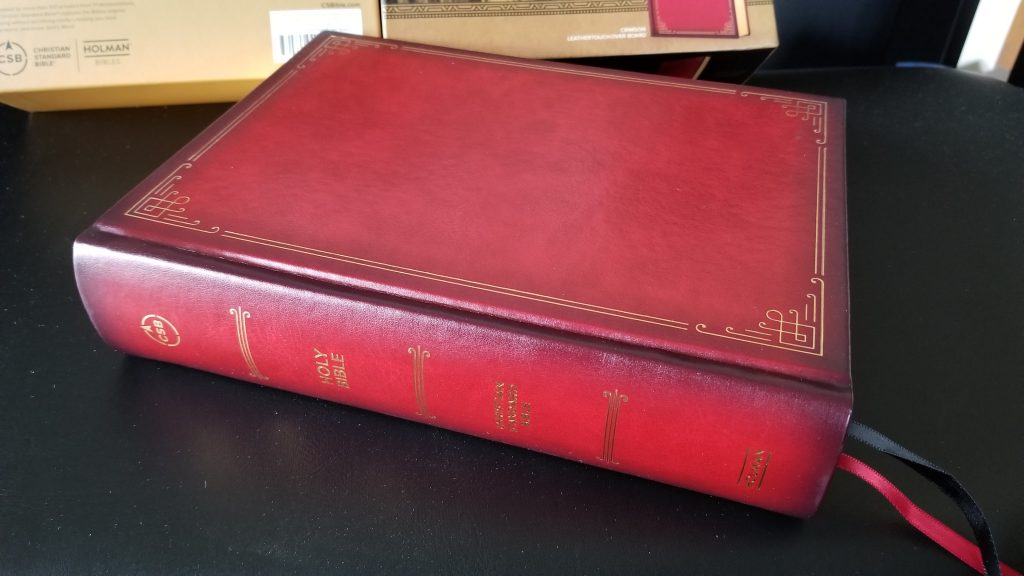
The bible comes in a protective box. The front of the box is pictured at the top of this post. Here is a photo of the back, with some additional description of the bible’s features:
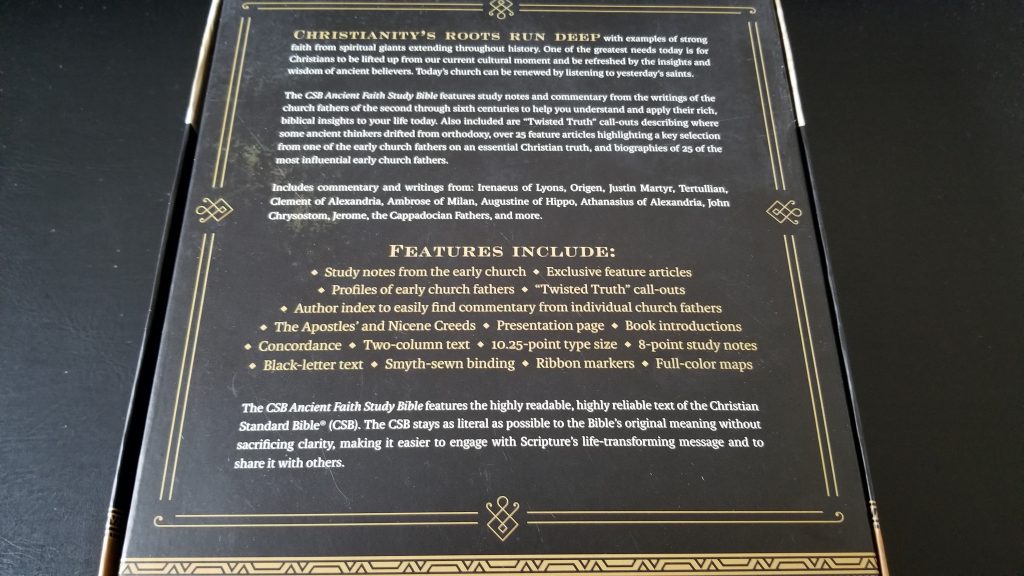
The page edges feature gold gilding which is medium quality. It doesn’t rise to the smoothness and durability of the gilding on Cambridge bibles, but it’s better than the spray-on gilding used on many cheap imitation leather editions.
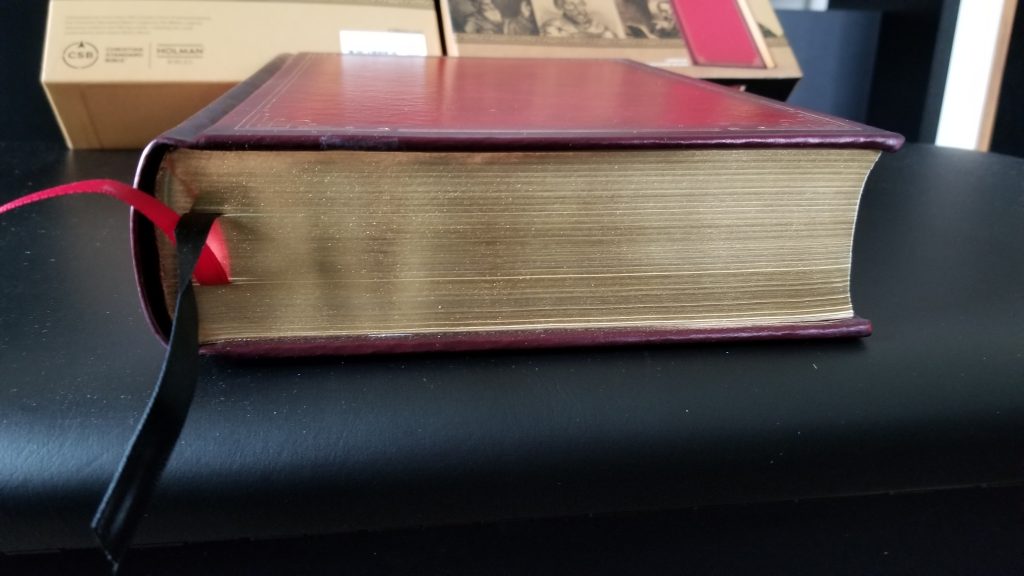
This is a fairly large bible overall. Its size and weight remind me of the New Oxford Annotated Bible (NOAB). This is probably an edition that most readers will use as a desk reference, rather than a bible they carry on a regular basis.
On the inside, I was struck by the sheer quantity of commentary by the early church fathers. This is truly a complete study bible (minus the deuterocanonical books) with all the commentary written by the patristic writers. Take a look at this page from the Gospel of John:
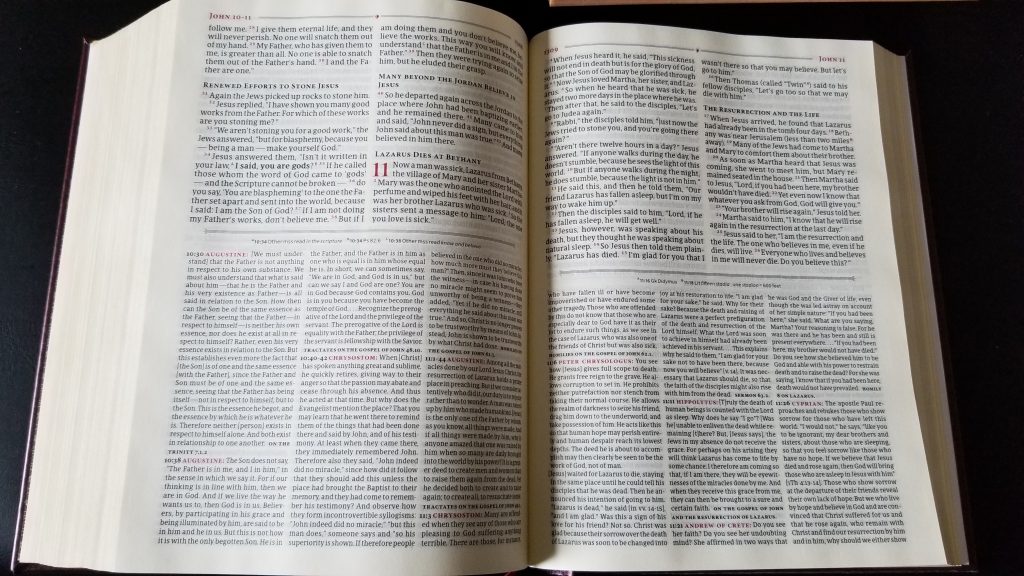
The bible text size is 10.25, and the notes are size 8. The bible text is very readable. There is moderate ghosting from text on adjacent pages, but the text is line-matched to improve readability. The font has an old-style feel to it. I’m not a fan of retro-style fonts. I would have preferred a simple, neutral, modern font. The text is easy to read, though, and that’s the main thing that matters.
Here is one of the “Twisted Truth” insets from the Gospel of John:
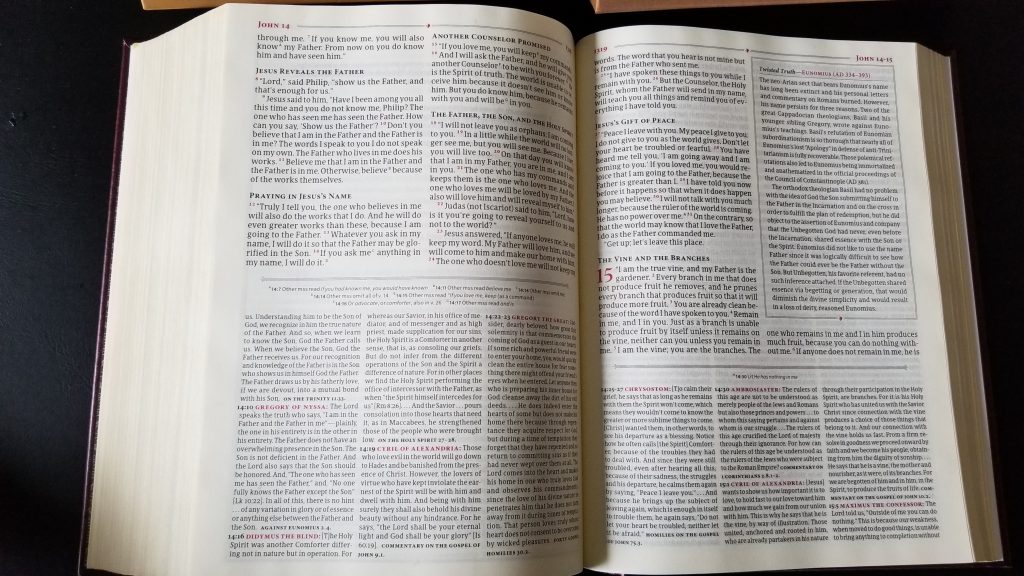
This inset provides interesting background on one of the early heresies. So far, from cursory viewing, I have not seen anything objectionable from a Catholic perspective. On the contrary, the sheer volume of information and commentary from the church fathers is an amazing resource. Despite the lack of the deuterocanonical books, this bible could be a very worthwhile resource for Catholics. Over the next week, I’m going to work my way through the Gospel of John, reading all the commentary as I go. Stay tuned for further information!
“Ancient Faith Publishing” is the name of an Pan-(Eastern) Orthodox publishing company in the English speaking world. This company and eastern orthodoxy in general places an extremely high emphasis on Patristic, much more than even Catholics. So this would be a major coincidence if a study Bible with commentary from the Church Fathers bore the name “Ancient Faith.” Do you know if this may be a collaboration with Ancient Faith Publishing?
This looks like a Bible I would be very much interested in.
The copyright page for this bible has the following note: “Study notes are adapted from the volumes in the Ancient Christian Commentary on Scripture Series edited by Thomas C. Oden. (C) 1998-2013 by the institute of Classical Christian Studies, Thomas C. Oden and Volume Editor(s). Used by permission of InterVarsity Press”
Just ordered mine and I’m stoked!
The Ancient Christian Commentary on Scripture Series, if you are not aware, is a truly ecumenical project. I borrowed the Exodus commentary and found it engaging. In the introduction it noted that there was heavy Catholic and Orthodox scholarly involvement. Including the Augustian Patristic institute in Rome.
It is supposed to take a Mere Christianity approach and build consensus across East and West. You shouldn’t see much commentary that would highlight confessional differences.
The full set of commentaries is about $1500.
http://www.ivpress.com/ancient-christian-commentary-on-scripture
It also includes the Deutorcanonical Books.
So to have even an edited version of this commentary at an affordable price is amazing.
I am looking forward to your review.
Thank you for the info, Devin. I hadn’t heard about this set of commentaries until yesterday!
One of these days I hope to work my way through purchasing the ACCS volumes. If you purchase one a month, you’ll have the whole thing in about two and a half years, or less than that if you bundle a few occasionally.
I managed to find the paperback set from books etc. at around $650. The paperback set includes an extra volume with biographies and timelines.
The Ancient Christian Commentary series is available for the Kindle for less than $20 per volume.
There is something seriously wrong at Lifeway. I’m not sure what happened, but the fact that the Christian Standard Bible (originally called the ‘Holman Christian Standard Bible’) has undergone so many radical changes in such a short time is a sign of a serious lack of direction at Lifeway.
The full story is fascinating, so I will tell it. The genesis (no pun intended) of the CSB began in 1996 when the International Bible Society published the ‘New International Version: Inclusive Language Edition’ in England (no Bible under that name has ever been published in the US). At the time, this was a highly controversial edition, and it led directly to both the ESV and the CSB. And led to the NIV being dropped by several conservative evangelical denominations, including both the Southern Baptist Convention and the Lutheran Church Missouri Synod.
In response to the publication of the NIV Inclusive Language Edition, the Southern Baptist Convention which had been using the NIV since the early ’80s, dropped it. There was concern within the SBC over the fact that they were using a translation which was controlled by an international organization, the International Bible Society, over which they had no influence. So the IBS could do whatever they wanted to the NIV, and they were powerless to do anything about it.
In addition, they were also getting tired of the expense of paying licensing fees to the IBS for using the NIV in printed materials, such as Sunday School lessons. So the decision was made that it would be more cost-efficient if they had their own translation that they controlled and for which they would not have to pay licensing fees.
The original plan was to purchase the rights to another translation, there were negotiations with the Lockwood Foundation to buy the NASB, and apparently, at one point they became really close to a deal, but it fell apart at the last minute.
At this point, they purchased the rights to a new translation that was being made by Farrell Till.
The introduction to the HCSB doesn’t mention any of this history, offering the standard boilerplate of ‘new scholarships’ and ‘changes in the English language’ that every other translation claims (falsely) at the reason for the translation.
The Holman Christian Standard Bible was published in full in 2004, and there were several distinctive features, including the use of the divine name ‘Yahweh’. In 2009, a second edition was published which doubled down on all the most distinctive features. The advertising also strongly emphasized these distinctive features.
Then, there was a radical upheaval in the leadership of the SBC, with the entire upper leadership being dismissed and replaced with a younger generation. As a result, all of the translators of the 2004 and 2009 editions were dismissed from their positions and work on a third edition began. This third edition, which was published in 2017, was published without fanfare and eliminated all of the most distinctive features of the translation which only a couple years earlier the advertising was still trumpeting as the reason why the HCSB was the best translation. Moreover, the word ‘Holman’ was removed from the name of the Bible.
I think the fact that there have been such radical changes in this translation over such a short period of time is a sign of a complete lack of direction and perhaps a bit of a warning about the dangers of a major translation being owned entirely by one denomination, a denomination in which there is often upheaval and radical changes of leadership. The SBC is a denomination known for frequent changes in leadership and often radical changes in policy and direction. If this continues, I think the future will see further revisions in the CSB and each revision will put the translation in a different direction. I don’t think it will ever be a stable translation.
Thanks for the background info, BC. I’m looking forward to spending some time with the CSB this week and comparing it to the NABRE. So far, after reading the first two chapters of John, I haven’t run into anything that seems excessively paraphrased. In some cases, it appears more literal than the NABRE. The best example is at the wedding feast at Cana. In John 2:4, Jesus responds to Mary’s statement that the wedding party has run out of wine. In the NABRE, he says “Woman, how does your concern affect me? My hour has not yet come.” In the CSB, he says “What does that have to do with you and me, woman? My hour has not yet come.” Dr. Edward Sri often uses a literal rendering of this passage similar to the CSB’s translation when he explains the meaning of this verse.
I’m not very familiar with the 2017 version, but I am with the 2009 edition. Even though it is owned by the Southern Baptist Convention, I would not call it a ‘Baptist Bible’, it seems to avoid an overt Baptist bias, for example, they could have translated the word for ‘baptize’ as ‘immerse’, but chose not to do so.
There is a little bit of literalism in the CSB’s tendency to translate verbs in the present tense. For example ‘keep on knocking and the door will be opened’ and Christ’s promise to Peter ‘I give you the keys to the kingdom….whatever you bind will already have been bound in heaven…’ (this translation is also found in the NASB) both of these translations are defensible on grammatical grounds, but they are rather unnatural English and it seems they were translated this way for ideological, rather than grammatical, reasons.
I have to admit, I always laugh a little when I read the introduction to a new translation, and see that it brags about being ‘ecumenical’ because there were translators from ‘several conservative evangelical denominations’, this kind of statement appears in the introduction to the NIV, NASB, and CSB. Som all the translators were evangelicals? That isn’t ecumenical. So, there is no real theological diversity at all then?
Say what you will about the NRSV, REB, and NABRE, but at least these translations are GENUINELY ecumenical, with translators who represent a genuine theological diversity, with Protestant (from several denominations, liberal and conservative both), Catholic, Orthodox and even Jewish members on the translation team. The NRSV, REB, and NABRE are genuinely unbiased in favor of any particular theology whereas the NIV, NASB, and CSB are overtly biased in favor of evangelical theology.
I am a huge fan of the CSB. I was raised Evangelical but now am Eastern Orthodox and I still prefer the CSB translation. If only it had the deutero-canonicals!
Marc, please keep us updated as to the commentary. I am interested in this study bible, but I am curious if their protestant bias really comes through in how they handle the Church Father’s commentaries.
What did they do with Romans 9? Do they rely entirely on Augustine?
Being Orthodox for many years , I would say get a copy of the English Translation of the LXX and a Orthodox copy of the New Testament . I Just purchased this Bible as well , but I also have a Sir Lancelot Brenton copy of the LXX in my possession .
Do you know if there is a Catholic Bible that does a bible similar to this? Why haven’t they come out with one yet?
I’m not aware of a Catholic Bible that is exactly like this. The Navarre Bible contains extensive commentary, with writings of the Church Fathers, but it is a multi-volume commentary. The Didache Bible features study notes that are based on the Catechism, and the Ignatius Catholic Study Bible (multi-volume) features notes that integrate Scripture with the teaching of the Church. I’m not aware of any other single-volume Bible where the notes are exclusively excerpts from the Church Fathers, though. It’s truly a fantastic resource.
Thanks for the information. I just came across this and any patristic commentary connection to the scriptures is welcome in my corner. There is a very helpful book called the Bible and the Holy Fathers which takes the Orthodox lectionary readings and inserts patristic texts to inform the reader. It was done decades ago and has been in and out of print. The text is King James.
The Ancient Christian Commentary is very helpful and a wonderful contribution in English but unfortunately because it was done outside of the consensus of the Church (nothing against the people who did it) it occasionally slips into a couple of problems – such as quoting fathers whose teaching went outside the bounds of Holy Tradition of the entire Church. There were other things I came across which lack the full meaning in translation most likely because they lack the Orthodox context (such as the liturgical setting of the patristic preacher). I would be curious to see who’s raising the Twisted Truth flags – if coming at it from a perspective based on Protestant ideas 1000 years after the patristic writing and 1500 years after the scripture texts were written. Invariably you have to go back to the Holy Tradition and the ecumenical councils to ground such things – but I don’t know that the bible’s editors come from that place.
One obvious weakness with this translation will be that it was not based on the Septuagint, which was the translation used throughout the early Church and the Greek world (including the West). So those important differences might be lost in reading this translation.
That said, it sounds like a worthwhile effort and worth picking up.